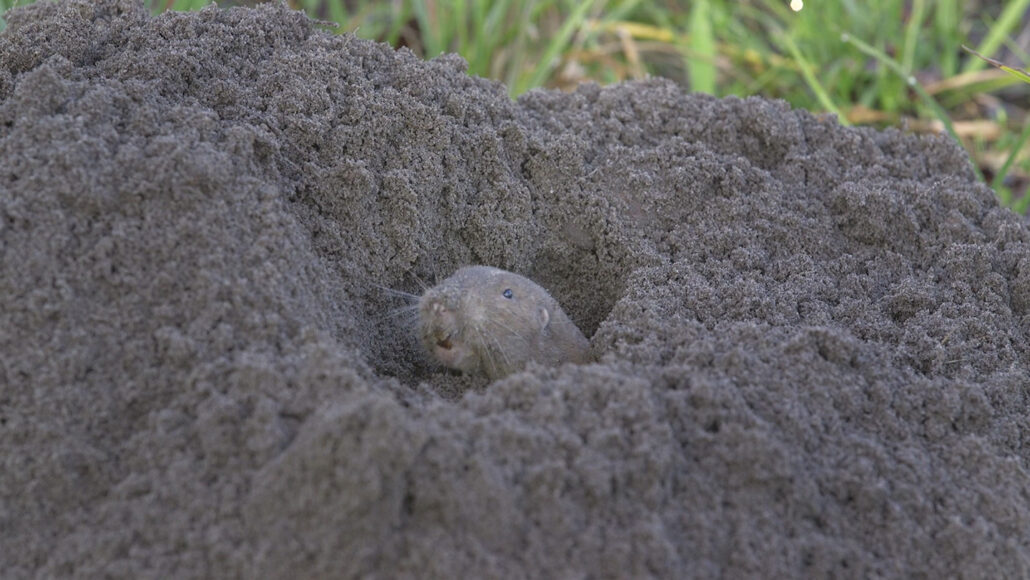Gophers might be farmers, a controversial study suggests
The rodents encourage root growth in their underground tunnels, it finds

Southeastern pocket gophers use a lot of energy digging tunnels. They might get some of that energy by “farming” roots in those tunnels, a controversial study now suggests.
Veronica Selden/Eurekalert (CC BY-SA)
Pocket gophers might give a whole new meaning to the phrase “farm animal.”
New research hints that these rodents might improve conditions for root growth inside their underground tunnels. This could help the root-eating gophers get enough food in areas that do not naturally contain lots of roots. If gophers do purposely aid the growth of food in this way, it might count as a simple type of farming.
Two researchers proposed this idea in the July 11 Current Biology. One was Jack Putz. He’s an ecologist at the University of Florida in Gainesville. The other was his former zoology student, Veronica Selden.
Some scientists think it’s a stretch to call the rodents farmers. The reason: Gophers may not be actively working the soil. Rather, they might just accidentally alter their environment as they eat and poop their way around. And all animals do that.
Convincing skeptics that gophers are true farmers will therefore take a bit more digging into the rodents’ behavior.
Getting the dirt on gophers
Gophers spend a lot of energy digging their tunnels. In fact, that digging takes up to 3,400 times as much energy for gophers as does walking along the surface. That made Selden and Putz curious about where the critters got all this energy. So in 2021, the two began investigating some southeastern pocket gophers (Geomys pinetis) in Florida.
The pair took root samples from soil near 12 gopher tunnels. That allowed them to estimate how much root mass a gopher would encounter as it dug a meter (39-inch span) of tunnel. Then the researchers calculated how much energy (calories) those roots would provide.
“We were able to compare energy cost versus gain,” Selden says. And on average, they calculated, digging cost the gophers about as many calories as the roots provided.

Selden and Putz also examined some gopher tunnels. Poop was spread along the insides of those passages. Gophers also seemed to have taken little bites out of roots. The animals seemed to have stirred up the soil, too.
All of this led Selden and Putz to conclude that the gophers had provided conditions that favored root growth in their tunnels. Their poop served as fertilizer. By stirring up the soil, the animals had allowed it to air out. This would give roots more room to grow. It also would make it easier for the roots to absorb water and nutrients from the soil. And repeatedly nibbling on roots could encourage new sprouting.
“All of these activities encourage root growth,” Selden says. She and Putz now think this amounts to a basic form of farming. If so, that would make gophers the first mammals other than humans known to farm. (Other creatures, such as some insects, started farming long before people did).
Are gophers really so special?
The idea of gopher farming has its skeptics. One is J.T. Pynne. A wildlife biologist at the Georgia Wildlife Federation in Covington, he studies southeastern pocket gophers.
“I don’t really think you can call it farming,” Pynne says. “All herbivores eat plants. And everybody poops.” So nibbling roots and pooping in tunnels might not be signs of farming. They could just be the result of gophers doing what all animals do.
Ulrich Mueller agrees. He’s an evolutionary biologist at the University of Texas at Austin. If gophers count as farmers, he says, “then most mammals and most birds are farmers.” These animals also create good growing conditions for some of the plants on which they feed. Take cows, for example. Their poop fertilizes the grass they eat. But farmers do not typically consider cows their colleagues.
Selden understands this doubt. She knows that because gophers don’t plant their crops, not everyone is comfortable calling them farmers. Still, she argues that gophers stand out among other plant-eating, pooping animals. “What qualifies the gophers as farmers and sets them apart from, say, cattle … is that gophers cultivate and maintain this ideal environment for roots to grow.”
Saying gophers are farmers may actually hurt trust in science, Mueller adds. The public will see through “the shallowness of the data,” he worries. And that may lead some to think science is “just a bunch of storytelling.”
At the very least, Putz hopes their research makes people kinder toward the rodents. “If you go to the web and put in ‘pocket gopher,’ you’ll see more ways to kill them than you can count,” he says. If people see gophers as clever little critters rather than pests, they might treat these animals better.







